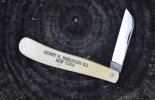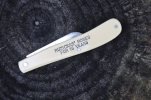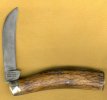-
The BladeForums.com 2024 Traditional Knife is available! Price is $250 ea (shipped within CONUS).
Order here: https://www.bladeforums.com/help/2024-traditional/
You are using an out of date browser. It may not display this or other websites correctly.
You should upgrade or use an alternative browser.
You should upgrade or use an alternative browser.
Macho or Not So!!??
- Thread starter waynorth
- Start date
waynorth
Dealer / Materials Provider
- Joined
- Nov 19, 2005
- Messages
- 33,346
Did I mention that the Harrison Brothers knife is hollow-ground, like a razor blade!!??
With a little better honing, it will surely slice Jalapenos - extra thin if needed!! It is now a challenge to me to improve the edge!! (It only needs a little TLC!!)
With a little better honing, it will surely slice Jalapenos - extra thin if needed!! It is now a challenge to me to improve the edge!! (It only needs a little TLC!!)
- Joined
- Dec 2, 2005
- Messages
- 71,073
I was lucky to acquire this lovely Harrison Brothers and Howson Budding knife yesterday, from a friend who knows what kind of knives brighten my day!! I studied this apparently simple knife for a while and noticed some interesting things! It's not so simple!!
Very few parts in a careful arrangement make a worthy tool!!
The handle is one piece, sawn differently at backspring and gullet. The spring is tapered, and set into a notch in the handle/body, and requires only one pin! The other pin allows the blade to pivot and snap!! Delicate in appearance yet sturdy in function, this knife is referred to by the etch as THE ALPHA KNIFE!!!A Rough and Ready name, yet a svelte configuration! The blade is nicely swedged (and poorly honed) and the handle donated by a long-ago elephant, is shapely and functional! The oddest knives are functional and beautiful in this collector business!!!
View attachment 1189190 View attachment 1189191 View attachment 1189192 View attachment 1189193 View attachment 1189194
Great-looking Budding/Grafting Knife Charlie, and a generous gift

I have, or have seen, others with separate spuds of ivory, horn, and (later) brass, but even the modern versions of this pattern generally emulate the ivory models.
Harrison Brothers & Howson were one of Sheffield's most pre-eminent cutlers, with a Royal Warrant granted by Queen Victoria (and a later one granted by Edward VII). Please see my series The Dairy Maids of Porter Brook, which mentions some of the firm's early history in Part 2

The company originated with George Howson, who was apprenticed at at Thomas Sansom & Sons in 1803, where he eventually became a partner. George died in 1847, after which his son William (1822-1884) took over his father's business. In 1849, William went into partnership with two brothers - James William Harrison (1816-1897) and Henry Harrison (1825-1893), and they took over Sansom & Sons to establish Harrison Brothers & Howson (though later advertising date the company to 1836). Like the older Joseph Rodgers & Sons, they were based on Norfolk Street (no 45) in the very centre of Sheffield.
William Howson became the firm's traveller, while Henry Harrison relocated to America. In the 1860's, Henry Harrison, (who became Sheffield's Master Cutler in 1862), told a government commission (I have the full transcript) that half the company's work was done off the premises by outworkers, with all the grinding being done in around a dozen different wheels (including several along the Porter Brook). In 1875, William Howson resigned from the partnership, leaving more than £50,000 when he died at his mansion on the edge of Sheffield in 1884.
The company continued to expand under the Harrisons. They had registered a silver mark in 1849, and targeted the growing silver and electro-plate trade, transferring this work to Shoreham Plate Works in Shoreham Street in 1879. In the 1881 census, Harrison Brothers & Howson recorded that they employed 257 workers (139 men, 61 boys, 39 women, and 18 girls).
The Industries of Sheffield (1888) gives an interesting account of the factory:
"At their cutlery works three hundred men are in constant work. On the first floor of the building are the offices - large, handsome and well-appointed rooms; adjoining is a heavily stocked showroom, where ivory stock of every description is exhibited; near this is another showroom devoted to the display of butchers' and other knives, carvers, and forks to match, and smaller knives of chaste design and wonderfully fine and careful finish. These goods are packed in handsome plush cases, and from this room are dispatched to various parts of the world, North America and Australia absorbing an immense quantity. Descending from these rooms into large and spacious yard, we found about twenty forges in operation, two skilled artizans attending to each. At the side of this is the ivory-cutting shop, and underneath the yard are extensive and well-lighted cellars, which are utilized as warehouses for the Egyptian horns and African elephants tusks, which the firm import direct in immense quantities, and which are destined eventually to find their way to the dinner-table in the shape of knife handles. A great point of interest is found here in the powerful steam engine, by means of which the machinery throughout the factory is set in motion. Above the yard are seven shops for the different departments into which the manufacture of the products of the factory is divided."
George Howson (1851-1930), William's son, joined the business in 1867, becoming a partner after his father's retirement in 1875. Henry Harrison retired in 1892, dying the following year, and leaving close to £124,000 in his will. James William Howson died in 1897, one of the wealthiest men in Sheffield, leaving a fortune of £239,675. Francis W Harrison, Henry's son, died in 1898, aged just 38, leaving £62,000.
George Howson became Master Cutler (ie Chief of the factory owners) in !893, and made two world tours to promote the company and its products. In spite of US cutlery tariffs, in the 1890's, Harrison Brothers & Howson had agencies in New York and San Francisco.
By the start of the 20th century, with most of the Harrisons having passed out of the firm, the Howsons were dominant, and with the firm now employing 700 workers, and their existing premises becoming increasingly cramped, they moved to the Alpha Works.


The Alpha corporate mark used by Harrison Brothers & Howson had originally been granted to another Sheffield cutler, Samuel Harwood in 1836, but passed out of use in the 1850's, and was later acquired by the company. They also acquired several other Sheffield cutlery firms, and their marks, including the 'Stag's Head' mark of William Webster, and the 'SLASH' mark of Charles Ibbotson.
The building of the new factory, modern for the time, did not turn out to be a wise financial investment for the company though, and while they were now one of the city's largest firms, the profits they expected to see after moving into the new premises did not materialize. In 1908, George Howson bemoaned the decision, speculating that he would have been better employing outworkers than building the new factory.
Harrison Brothers & Howson, like other Sheffield manufacturers, began to go into decline, though the owners still retired rich. George Howson was still head of the company when he died at his mansion in 1930, leaving nearly £40,000. The firm subsequently passed to the descendants of the owners, and was still the last privately owned company in Sheffield when it was acquired by the disreputable Viners in 1959.
Campbellclanman
Platinum Member
- Joined
- Mar 10, 2007
- Messages
- 15,820
How they didnt crack that Ivory eh Charlie? nice work by absolute Tradesmen!
Such great back-up with the history Jack my friend! Now THAT'S what you call a Stove-Pipe Kick eh Jack


Such great back-up with the history Jack my friend! Now THAT'S what you call a Stove-Pipe Kick eh Jack

- Joined
- Feb 15, 2019
- Messages
- 628
Nice knife but don't let Crocodile Dundee see it.
pistonsandgears
Gold Member
- Joined
- Aug 12, 2011
- Messages
- 3,073
Impressive craftsmanship there. I've never seen a slipjoint with a tapered back spring.
- Joined
- Dec 2, 2005
- Messages
- 71,073
Such great back-up with the history Jack my friend! Now THAT'S what you call a Stove-Pipe Kick eh Jack


Thanks pal, hope you're keeping well

Augie
Gold Member
- Joined
- Aug 23, 2014
- Messages
- 3,936
I was lucky to acquire this lovely Harrison Brothers and Howson Budding knife yesterday, from a friend who knows what kind of knives brighten my day!! I studied this apparently simple knife for a while and noticed some interesting things! It's not so simple!!
Very few parts in a careful arrangement make a worthy tool!!
The handle is one piece, sawn differently at backspring and gullet. The spring is tapered, and set into a notch in the handle/body, and requires only one pin! The other pin allows the blade to pivot and snap!! Delicate in appearance yet sturdy in function, this knife is referred to by the etch as THE ALPHA KNIFE!!!A Rough and Ready name, yet a svelte configuration! The blade is nicely swedged (and poorly honed) and the handle donated by a long-ago elephant, is shapely and functional! The oddest knives are functional and beautiful in this collector business!!!
View attachment 1189190 View attachment 1189191 View attachment 1189192 View attachment 1189193 View attachment 1189194
Charlie, beautiful horticulture knife, funny that you should start this thread right now as I just picked up a Schrade Cut Co Florist knife in French Ivory this week. High condition and marked Henry M. Robinson Co which was a horticulture and nursery supply company and on the other side marked Ruzicka's Roses For 16 years, I can find reference that Ruzicka's started 1908 so that would put the knife at 1924.
Apparently supplying roses to New York City was a huge business with the roses grown in Madison New Jersey and transported by train daily to New York City.
http://www.njskylands.com/history-madison-roses


- Joined
- Dec 2, 2005
- Messages
- 71,073
Thanks for that rich bit of History, Jack!!You are our resident Professor of Sheffield!!

Thanks Charlie!

- Joined
- Aug 23, 2019
- Messages
- 881
Nice to see ivory every now and then.
Marvelous knife.
Marvelous knife.
meako
Gold Member
- Joined
- Sep 4, 2006
- Messages
- 10,069
Who said I aint got no macho? I'll moidalise 'em.
But first I'd like you all to see my Mr Lincoln Rose.....when I moved to my new house this rose was hopelessly stalky and overgrown.
A good hard prune back to the wood and a spoonfull of rose food at the base...it pumped out 4 magnificent flowers one after the other ....during the middle of winter...not cold here....anyway...the point is ...they are the result of grafting....and thats what its all about...just wish you could smell them....delightful....
Cheers

But first I'd like you all to see my Mr Lincoln Rose.....when I moved to my new house this rose was hopelessly stalky and overgrown.
A good hard prune back to the wood and a spoonfull of rose food at the base...it pumped out 4 magnificent flowers one after the other ....during the middle of winter...not cold here....anyway...the point is ...they are the result of grafting....and thats what its all about...just wish you could smell them....delightful....
Cheers

CVamberbonehead
Gold Member
- Joined
- Nov 6, 2017
- Messages
- 2,242
Not the most macho knife, but very cool.  The most macho ones are found in only the finest of gas stations and flea markets, for only the most discerning tacticool operators. So I wouldnt worry too much about macho, its over rated.
The most macho ones are found in only the finest of gas stations and flea markets, for only the most discerning tacticool operators. So I wouldnt worry too much about macho, its over rated.
Ive never seen a handle like that, thats really cool. What an amazing bit of craftsmanship! And the ivory is gorgeous. Awesome knife, thanks for sharing.
Ive never seen a handle like that, thats really cool. What an amazing bit of craftsmanship! And the ivory is gorgeous. Awesome knife, thanks for sharing.


